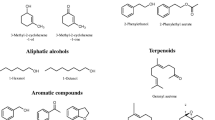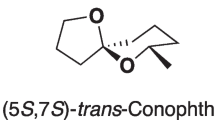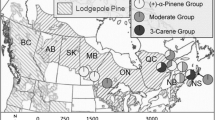Abstract
Antennally active nonhost angiosperm bark volatiles were tested for their ability to reduce the response of three common species of coniferophagous wood-boring Cerambycidae to attractant-baited multiple funnel traps in the southern interior of British Columbia. Of the nonhost volatiles tested, only conophthorin was behaviorally active, disrupting the attraction of sawyer beetles, Monochamus spp., to traps baited with the host volatiles α-pinene and ethanol and the bark beetle pheromones ipsenol and ipsdienol. Conophthorin did not affect the attraction of sawyer beetles to the host kairomones α-pinene and ethanol in the absence of bark beetle pheromones, nor did it have any behavioral effect on adults of Xylotrechus longitarsis, which were not attracted to bark beetle pheromones. These results indicate that conophthorin does not act as a general repellent for coniferophagous Cerambycidae, as it seems to do for many species of Scolytidae, but has the specific activity of disrupting the kairomonal response of sawyer beetles to bark beetle pheromones.
Similar content being viewed by others
References
Allison, J. D., Borden, J. H., Mcintosh, R. L., DE Groot, P., and Gries, R. 2001. Kairomonal response by four Monochamus species (Coleoptera: Cerambycidae) to bark beetle pheromones. J. Chem. Ecol. 27:633–646.
Allison, J. D., Morewood, W. D., Borden, J. H., Hein, K. E., and Wilson, I. M. 2003. Differential bio-activity of Ips and Dendroctonus (Coleoptera: Scolytidae) pheromone components for Monochamus clamator and M. scutellatus (Coleoptera: Cerambycidae). Environ. Entomol. 32:23–30.
Arn, H., Städler, E., and Rauscher, S. 1975. The electroantennographic detector—A selective and sensitive tool in the gas chromatographic analysis of insect pheromones. Z. Naturforsch.. 30c:722–725.
Birgersson, G., Debarr, G. L., DE Groot, P., Dalusky, M. J., Pierce, H. D., Jr., Borden, J. H., Meyer, H., Francke, W., Espelie, K. E., and Berisford, C. W. 1995. Pheromones in white pine cone beetle, Conophthorus coniperda (Schwarz) (Coleoptera: Scolytidae). J. Chem. Ecol. 21:143–167.
Borden, J. H. 1995. Development and use of semiochemicals against bark and timber beetles, pp. 431–449, in J. A. Armstrong and W. G. H. Ives (Eds.). Forest Insect Pests in Canada. Natural Resources Canada, Canadian Forest Service, Ottawa.
Borden, J. H., Chong, L. J., Savoie, A., and Wilson, I. M. 1997. Responses to green leaf volatiles in two biogeoclimatic zones by striped ambrosia beetle, Trypodendron lineatum. J. Chem. Ecol.. 3:2479–2491.
Borden, J. H., Wilson, I. M., Gries, R., Chong, L., Pierce, H. D., Jr., and Gries, G. 1998. Volatiles from the bark of trembling aspen, Populus tremuloides Michx. (Salicaceae) disrupt secondary attraction by the mountain pine beetle, Dendroctonus ponderosae Hopkins (Coleoptera: Scolytidae). Chemoecology 8:69–75.
Byers, J. A., Zhang, Q.-H., and Schlyter, F. 1998. Volatiles from nonhost birch trees inhibit pheromone response in spruce bark beetles. Naturwissenschaften 85:557–561.
Dallara, P. L., Seybold, S. J., Meyer, H., Tolasch, T., Francke, W., and Wood, D. L. 2000. Semiochemicals from three species of Pityophthorus (Coleoptera: Scolytidae): Identification and field response. Can. Entomol. 132:889–906.
Day, R. W. and Quinn, G. P. 1989. Comparisons of treatments after an analysis of variance in ecology. Ecol. Monogr. 59:433–463.
Deglow, E. K. and Borden, J. H. 1998a. Green leaf volatiles disrupt and enhance response by the ambrosia beetle, Gnathotrichus retusus (Coleoptera: Scolytidae) to pheromone-baited traps. J. Entomol. Soc. Br. Columbia 95:9–15.
Deglow, E. K. and Borden, J. H. 1998b. Green leaf volatiles disrupt and enhance response to aggregation pheromones by the ambrosia beetle, Gnathotrichus sulcatus (Coleoptera: Scolytidae). Can. J. For. Res. 28:1697–1705.
de groot, P. and De barr, G. L. 2000. Response of cone and twig beetles (Coleoptera: Scolytidae) and a predator (Coleoptera: Cleridae) to pityol, conophthorin, and verbenone. Can. Entomol. 132:843–851.
DE Groot, P., Debarr, G. L., and Birgersson, G. 1998. Field bioassays of synthetic pheromones and host monoterpenes for Conophthorus coniperda (Coleoptera: Scolytidae). Environ. Entomol. 27:382–387.
Dickens, J. C., Billings, R. F., and Payne, T. L. 1992. Green leaf volatiles interrupt aggregation pheromone response in bark beetles infesting southern pines. Experientia 48:523–524.
Francke, W., Hindorf, G., and Reith, W. 1979. Alkyl-1,6-dioxaspiro[4.5]decanes—A new class of pheromones. Naturwissenschaften 66:618–619.
Gries, G. 1995. Prospects of new semiochemicals and technologies, pp. 44–47, in S. M. Salom and K. R. Hobson (Eds.). Application of Semiochemicals for Management of Bark Beetle Infestations—Proceedings of an Informal Conference. USDA Forest Service General Technical Report INT-GTR-318.
Huber, D. P. W. and Borden, J. H. 2001a. Angiosperm bark volatiles disrupt response of Douglas-fir beetle, Dendroctonus pseudotsugae, to attractant-baited traps. J. Chem. Ecol.. 27:217–233.
Huber, D. P. W. and Borden, J. H. 2001b. Protection of lodgepole pines from mass attack by mountain pine beetle, Dendroctonus ponderosae, with nonhost angiosperm volatiles and verbenone. Entomol. Exp. Appl. 92:131–141.
Huber, D. P. W., Borden, J. H., Jeans-Williams, N. L., and Gries, R. 2000a. Differential bioactivity of conophthorin on four species of North American bark beetles (Coleoptera: Scolytidae). Can. Entomol. 132:649–653.
Huber, D. P. W., Borden, J. H., and Stastny, M. 2001. Response of the pine engraver, Ips pini (Say) (Coleoptera: Scolytidae), to conophthorin and other angiosperm bark volatiles in the avoidance of non-hosts. Agric. For. Entomol. 3:225–232.
Huber, D. P. W., Gries, R., Borden, J. H., and Pierce, H. D., Jr. 1999. Two pheromones of coniferophagous bark beetles found in the bark of nonhost angiosperms. J. Chem. Ecol. 25:805–816.
Huber, D. P. W., Gries, R., Borden, J. H., and Pierce, H. P., Jr. 2000b. A survey of antennal responses by five species of coniferophagous bark beetles (Coleoptera: Scolytidae) to bark volatiles of six species of angiosperm trees. Chemoecology 10:103–113.
Kohnl, U., Densborn, S., Kölsch, P., Meyer, H., and Francke, W. 1992. E-7-Methyl-1,6-dioxaspiro[4.5]decane in the chemical communication of European Scolytidae and Nitidulidae (Coleoptera). J. Appl. Entomol. 114:187–192.
Kvanli, A. H. 1988. Statistics: A Computer Integrated Approach. West Publishing, St. Paul, Minnesota.
Lindgren, B. S. and Borden, J. H. 1993. Displacement and aggregation of mountain pine beetles, Dendroctonus ponderosae (Coleoptera: Scolytidae), in response to their antiaggregation and aggregation pheromones. Can. J. For. Res. 23:286–290.
Linit, M. J. 1988. Nematode-vector relationships in the pine wilt disease system. J. Nematol. 20:227–235.
Linsley, E. G. 1964. The Cerambycidae of North America, Part V: Taxonomy and Classification of the Subfamily Cerambycinae, Tribes Callichromini Through Ancylocerini (University of California Publications in Entomology, Vol. 22). University of California, Berkeley, California.
Linsley, E. G. and Chemsak, J. A. 1984. The Cerambycidae of North America, Part VII, No. 1: Taxonomy and Classification of the Subfamily Lamiinae, Tribes Parmenini Through Acanthoderini (University of California Publications in Entomology, Vol. 102). University of California, Berkeley, California.
Mcintosh, R. L., Katinic, P. J., Allison, J. D., Borden, J. H., and Downey, D. L. 2001. Comparative efficacy of five types of trap for woodborers in the Cerambycidae, Buprestidae and Siricidae. Agric. For. Entomol. 3:113–120.
Miller, D. R., Pierce, H. D., Jr., de groot, P., Jeans-williams, N., Bennett, R., and Borden, J. H. 2000. Sex pheromone of Conophthorus ponderosae (Coleoptera: Scolytidae) in a coastal stand of western white pine (Pinaceae). Can. Entomol. 132:243–245.
Morewood, W. D., Hein, K. E., Katinic, P. J., and Borden, J. H. 2002a. An improved trap for large wood-boring insects, with special reference to Monochamus scutellatus (Coleoptera: Cerambycidae). Can. J. For. Res. 32:519–525.
Morewood, W. D., Simmonds, K. E., Wilson, I. M., Borden, J. H., and Mcintosh, R. L. 2002b. α-Pinene and ethanol: Key host volatiles for Xylotrechus longitarsis (Coleoptera: Cerambycidae). J. Entomol. Soc. Br. Columbia. 99:117–122.
Phero Tech Inc. 1997. Damage assessment of wood borers in the interior of B.C. Final report, May 1997. Phero Tech Inc., 7572 Progress Way, Delta, British Columbia V4G 1E9.
Pierce, H. D., Jr., de groot, P., Borden, J. H., Ramaswamy, S., and Oehlschlager, A. C. 1995. Pheromones in red pine cone beetle, Conophthorus resinosae Hopkins, and its synonym, C. banksianae McPherson (Coleoptera: Scolytidae). J. Chem. Ecol. 21:169–185.
Poland, T. M., Borden, J. H., Stock, A. J., and Chong, L. J. 1998. Green leaf volatiles disrupt responses by the spruce beetle, Dendroctonus rufipennis, and the western pine beetle, Dendroctonus brevicomis (Coleoptera: Scolytidae) to attractant-baited traps. J. Entomol. Soc. Br. Columbia 95:17–24.
Poland, T. M. and Haack, R. A. 2000. Pine shoot beetle, Tomicus piniperda (Col., Scolytidae), responses to common green leaf volatiles. J. Appl. Entomol.. 24:63–69.
Rappaport, N. G., Stein, J. D., Del Rio Mora, A. A., Debarr, G., de groot, P., and Mori, S. 2000. Responses of Conophthorus spp. (Coleoptera: Scolytidae) to behavioral chemicals in field trials: A transcontinental perspective. Can. Entomol. 132:925–937.
SAS Institute Inc. 1999. The SAS System, Ver. 8. Cary, North Carolina.
Schroeder, L. M. 1992. Olfactory recognition of nonhosts aspen and birch by conifer bark beetles Tomicus piniperda and Hylurgops palliatus. J. Chem. Ecol. 18:1583–1593.
Shore, T. L. and Mclean, J. A. 1995. Ambrosia beetles, pp. 165–170, in J. A. Armstrong and W. G. H. Ives (Eds.). Forest Insect Pests in Canada. Natural Resources Canada, Canadian Forest Service, Ottawa.
Thöni, H. 1967. Transformations of variables used in the analysis of experimental and observational data. A review. Statistical Laboratory, Iowa State University. Technical Report Number 7.
Tømmerås, B. å. and Mustaparta, H. 1989. Single cell responses to pheromones, host and non-host volatiles in the ambrosia beetle Trypodendron lineatum. Entomol. Exp. Appl. 52:141–148.
Wilson, I. M., Borden, J. H., Gries, R., and Gries, G. 1996. Green leaf volatiles as antiaggregants for the mountain pine beetle, Dendroctonus ponderosae Hopkins (Coleoptera: Scolytidae). J. Chem. Ecol. 22:1861–1875.
Zar, J. H. 1999. Biostatistical Analysis, 4th edn. Prentice-Hall, Upper Saddle River, New Jersey.
Zhang, Q.-H., Liu, G.-T., Schlyter, F., Birgersson, G., Anderson, P., and Valeur, P. 2001. Olfactory responses of Ips duplicatus from Inner Mongolia, China to nonhost leaf and bark volatiles. J. Chem. Ecol. 27:995–1009.
Zhang, Q.-H., Schlyter, F., and Anderson, P. 1999. Green leaf volatiles interrupt pheromone response of spruce bark beetle, Ips typographus. J. Chem. Ecol. 25:2847–2861.
Zhang, Q.-H., Schlyter, F., and Birgersson, G. 2000. Bark volatiles from nonhost angiosperm trees of spruce bark beetle, Ips typographus (L.) (Coleoptera: Scolytidae): Chemical and electrophysiological analysis. Chemoecology 10:69–80.
Zhang, Q.-H., Tolasch, T., Schlyter, F., and Francke, W. 2002. Enantiospecific antennal response of bark beetles to spiroacetal (E)-conophthorin. J. Chem. Ecol. 28:1839–1852.
Author information
Authors and Affiliations
Corresponding author
Rights and permissions
About this article
Cite this article
Morewood, W.D., Simmonds, K.E., Gries, R. et al. Disruption by Conophthorin of the Kairomonal Response of Sawyer Beetles to Bark Beetle Pheromones. J Chem Ecol 29, 2115–2129 (2003). https://doi.org/10.1023/A:1025690519818
Issue Date:
DOI: https://doi.org/10.1023/A:1025690519818




